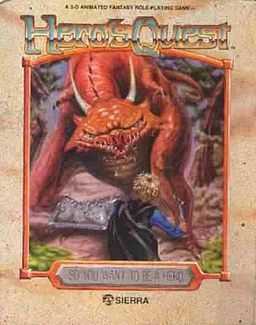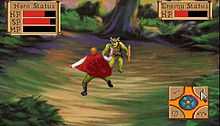Quest for Glory: So You Want to Be a Hero
| Quest for Glory: So You Want to Be a Hero | |
|---|---|
 Cover art of the 1989 version | |
| Developer(s) | Sierra On-Line |
| Publisher(s) | Sierra On-Line |
| Designer(s) | Lori Ann Cole |
| Series | Quest for Glory |
| Engine | SCI0, SCI1.1 (remake) |
| Platform(s) | MS-DOS, Amiga, NEC PC-9801, Atari ST |
| Release date(s) | Floppy: October 1989 (EGA), July 1992 (VGA) CD: April 1994 (VGA only) |
| Genre(s) | Adventure game/role-playing video game |
| Mode(s) | Single-player |
| Distribution | Floppy disks |
Hero's Quest: So You Want to Be a Hero (later re-released as Quest for Glory: So You Want to Be a Hero because of trademark issues involving the HeroQuest board game) is an adventure game/role-playing game hybrid, designed by Lori Ann Cole and published by Sierra On-line. It is the first game in the Quest for Glory series. Hero's Quest I has been credited for being a genre-defining game, as it tried to mix graphical adventure gaming with role-playing-like elements such as statistic building (strength, intelligence, health) that would actually have an impact on the ability to accomplish certain parts of the game, even as Beyond Zork had done the same for text adventures two years earlier.
Gameplay
The game advertised itself as "three games in one" since it was the first Sierra game that (according to RPG customs) allowed the selection of a character out of three classes: Fighter, Magic User, and Thief. What class the hero assigns to a character largely determines how they can solve puzzles and what quests they will run into. However, the distinction between classes was not an absolute one; players could add skills to a character and allow them to complete quests related to other classes in this game and others in the series.
Quest for Glory introduced a realism rarely found in RPGs and other adventure games even today. Day, night and the passage of time was a factor; the setting and scenery was different during day and night. The main character had to eat on a regular basis, he would become tired from running and fighting which required rest and sleep. Skills were not obtained by gaining levels through combat, but rather increased distinctly through the regular course of your adventuring. The more the player used magic, the more the Hero's Magic ability would increase (followed by Intelligence); likewise the more the player engaged in battle, training, or even cleaning the baron's stables, the more the Hero's Strength, Vitality and Agility would increase.
This is one of the few Sierra adventure games where the player character has few or no speaking lines. Although the player can input commands such as "ask about brigands", the player character has almost no dialogue.
Plot
In the valley barony of Spielburg, the evil ogress Baba Yaga has cursed the land and the baron who tried to drive her off. His children have disappeared, while the land is ravaged by monsters and brigands. The Valley of Spielburg is in need of a Hero able to solve these problems. The game follows the Hero, who is a customized adventurer whose name and class is chosen by player, on his journey into the land; he must help people and become a proclaimed Hero. In the novelized Authorized strategy guide,[1] he is named Devon Aidendale by the author.
The adventurer battles monsters, solves side quests (such as finding lost items and spell ingredients) and helps fantasy creatures such as a dryad, a hermit and a colourful collection of furry creatures called Meeps. Fulfilling quests will grant him experience and money, which he may use to buy equipment and potions. The game is open ended, which means the player can explore all the game at once and solve the quests in any order. During the quest, the character also meets recurring series characters such as the wizard Erasmus and his familiar Fenrus (or perhaps the other way around[2]), and first hears tales of the benevolent faery Erana.
While the game can be completed without solving the secondary quests, in the optimal ending, which nets the player the maximum score and serves as canon for the remainder of the series, the player frees the baronet from a powerful curse and thwarts the plans of the witch Baba Yaga. Finally, the adventurer frees the baron's daughter, Elsa von Spielburg, from the curse which had transformed her into the brigand leader. By doing so, the adventurer fulfills a prophecy, restores Spielburg Valley to prosperity, and is awarded the title of Hero. After this, the Hero, along with the merchant Abdulla Doo and the innkeepers Shameen and Shema, leaves on a magic carpet for Shapeir, the homeland of the three, setting the plan for the sequel, Quest for Glory II: Trial by Fire.
Development
Many planned features were cut off in the development progress, to release the game in a realistic amount of time. Originally, Lori had planned for four different races: thief-like gnome, magic wielding elf, human as jack of all trades, and archer centaur. For the limited resources in the animating department, races were replaced with multiple classes for the human character.[3] In the original design, there was supposed to be a big goblin maze. References to this have remained in the goblin base of the original version.[4] Many of the town buildings were planned to be enterable. Also, magic users were supposed to be able to get a familiar like Zara had, but it was cut due to programming difficulties.[5]
Reception
Computer Gaming World stated that the game's puzzles were easy, but still fun for an experienced player. It stated that excellent graphics and good use of humor and role-playing elements made the game "a definite winner".[6] In 1990 the magazine named it as Adventure Game of the Year, describing it as one of the few introductory games that both beginners and veterans of adventures enjoyed.[7]
Remake

Like the first games in the King's Quest, Space Quest, Police Quest, and Leisure Suit Larry series, a VGA version using Sierra's point and click SCI1.1 interpreter was released in 1992. This version had input limitations compared to the original, which used the text-parser–based SCI0. The VGA remake and original version were also released on CD-ROM as part of the 1996 Anthology collection and 1997 Collection Series.
While the original game was based on dialogues and asking questions in order to obtain some background information, in the new interface the dialogues had a tree structure: a menu of question topics. By asking certain questions (e.g., "Ask about Potion"), the player will get new questions to ask (e.g., "Healing potion", Stamina potion", "Dispel potion"). The backgrounds and characters were hand drawn and scanned, while the monster fights and character portraits were made using clay models and stop motion animation. Unlike other games, running out of stamina points here can kill the hero outright instead of starting to do health damage. Some easter eggs were also updated, for example in Erasmus's house, the original has a reference to King's Quest IV, while the remake has a reference to The Dagger of Amon Ra. The treasure room in the troll cave leading to the Brigand's hideout was missing in the remake.
References
- ↑ Quest for Glory: The Authorized Strategy Guide
- ↑ Fenrus: Erasmus is my familiar. / Erasmus: Isn't that the other way around? / Fenrus: Familiar is my Erasmus? Well, I've always found Erasmus to be overly familiar.... / Erasmus: No, no. I mean aren't you MY familiar? / Fenrus: Tsk, tsk. All these years and you still don't know. Sierra (1989-10-13). "Quest for Glory I" PC. Sierra.
- ↑ Transolar Games Entertainment: Hero's Quest
- ↑ "Live chat with Lori and Corey Cole". 31 March 2001. Archived from the original on 27 October 2009. – Corey Cole: QG1 was supposed to have a whole underground "Goblin Maze", but we had to cut it for lack of time and resources. I think there's still one reference to it that slipped through into the game.
- ↑ "Live chat with Lori and Corey Cole". 31 March 2001. Archived from the original on 27 October 2009. – Lori Cole: We wanted to have the Hero be able to have a familiar, like Zara in the first game. That was just too difficult to pull off in programming.
- ↑ Scorpia (January 1990). "Hero's Quest I". Computer Gaming World. p. 20. Retrieved 15 November 2013.
- ↑ "CGW's Game of the Year Awards". Computer Gaming World. September 1990. p. 70. Retrieved 16 November 2013.
External links
- Hero's Quest: So You Want To Be A Hero at MobyGames
- The Adventure Gamer - Hero's Quest: So You Want to Be a Hero?
| ||||||||||
| ||||||||||||||||||||||||||||||||||||||||||||||||||||||||||||||||||||||||||||||||||||||||||||||||||||||||||||||||||||||||||||||||||||||||||||||||